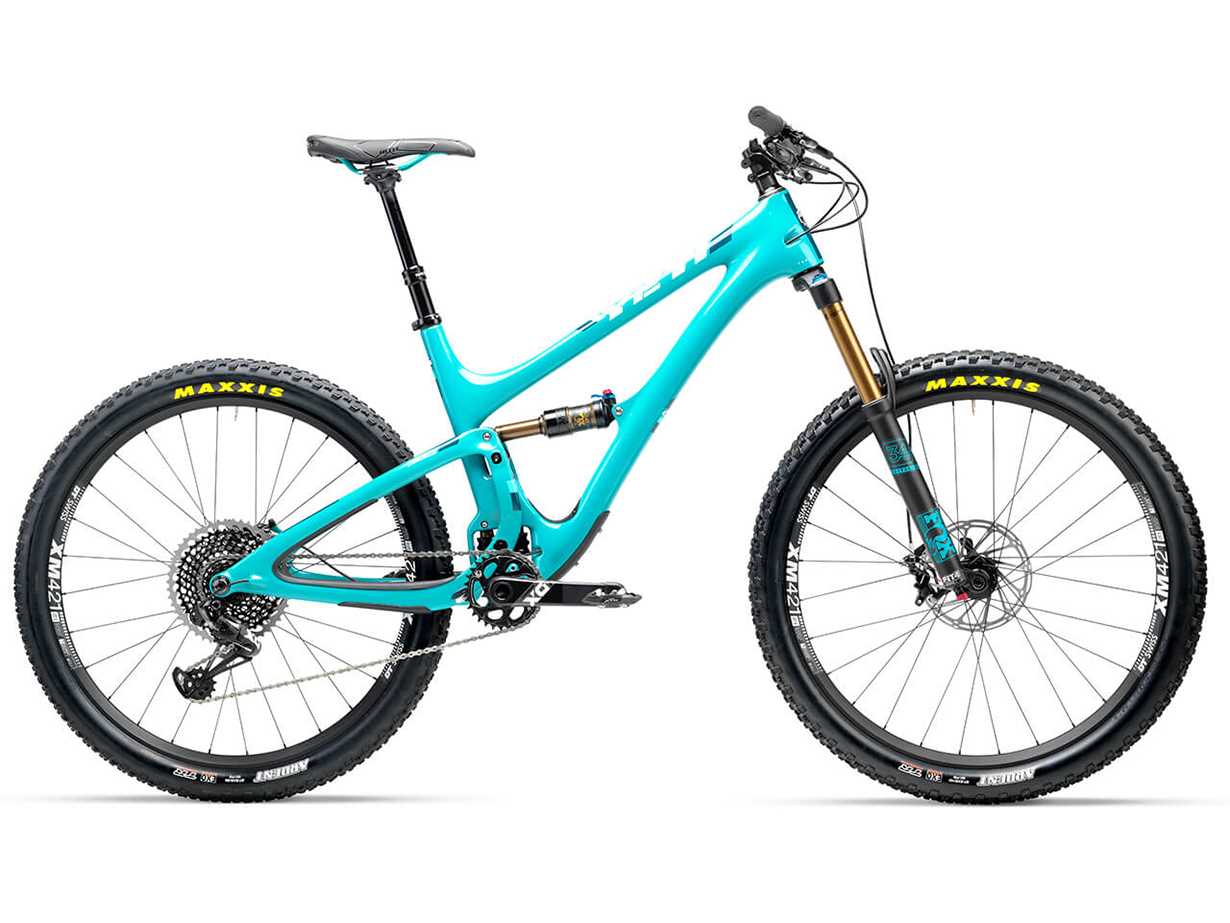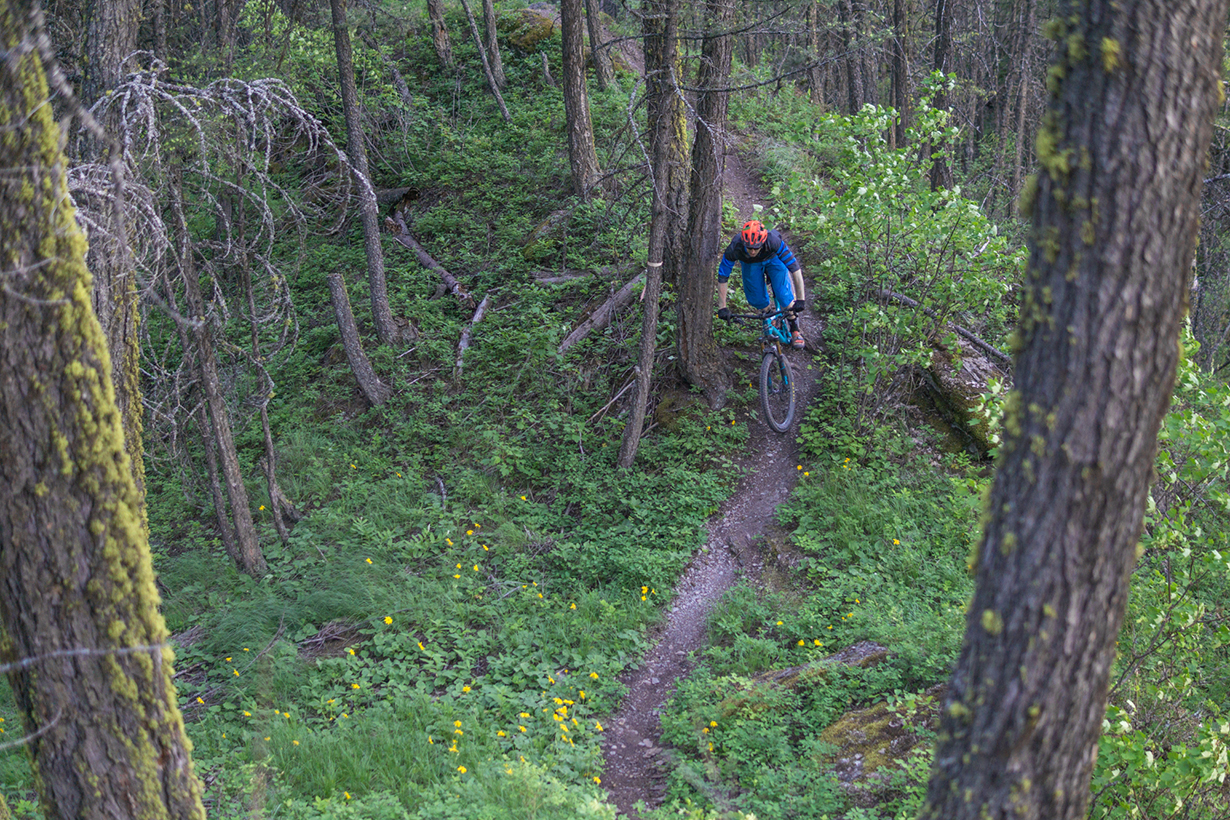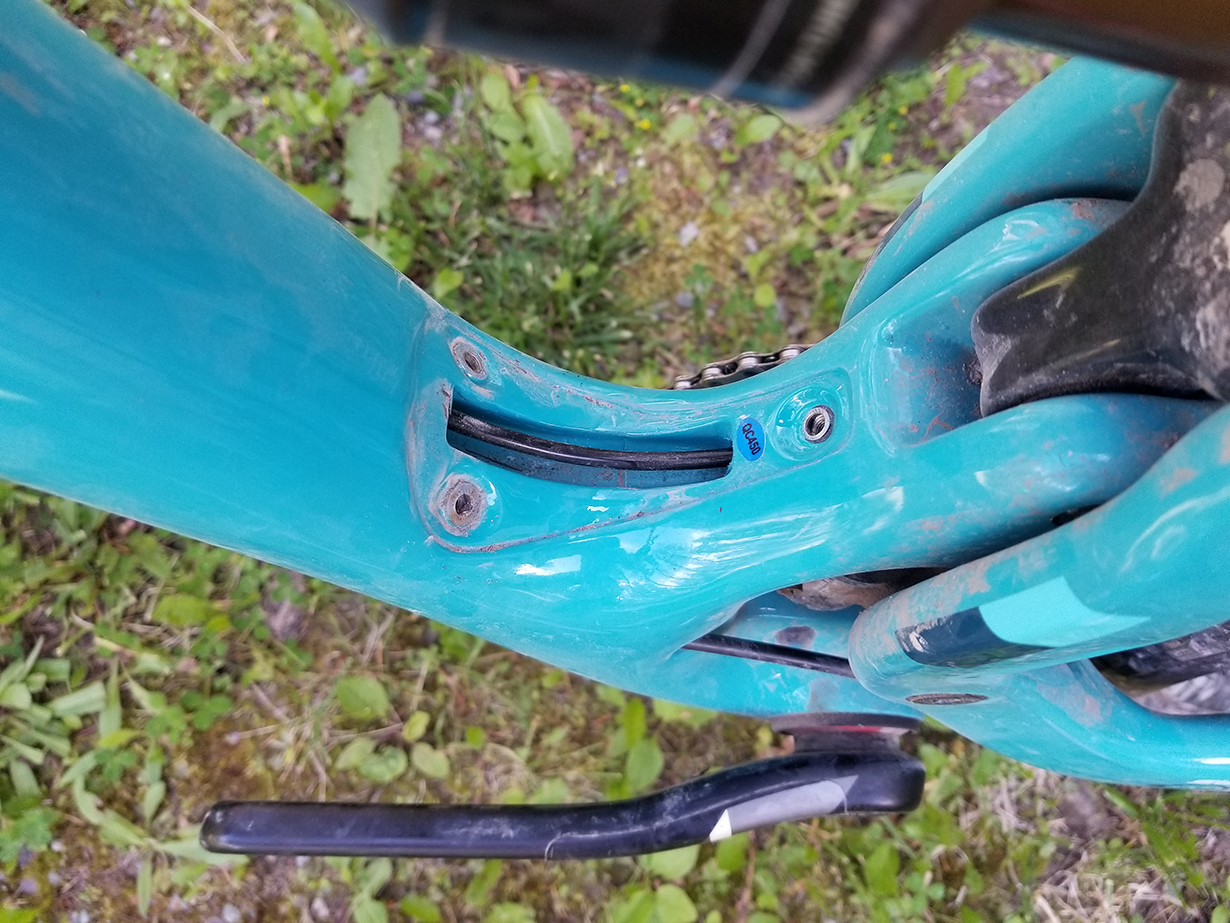2017 Yeti SB5
Size Tested: Medium
Geometry: (Here)
Build Overview:
- Drivetrain: Sram X01 Eagle
- Brakes: SRAM Guide RSC
- Fork: Fox 34 Factory FIT4
- Rear Shock: Fox Float Factory
- Wheels: DT Swiss 350 hubs w/ XM421 Rims
Wheels: 27.5′′
Travel: 127 mm rear / 150 mm front
Blister’s Measured Weight: 26.1 lbs (11.84 kg) without pedals
MSRP: $6,999
Reviewer: 5’9”, 155 lbs.
Test Location: Montana; British Columbia
Test Duration: ~2 months

Intro
The SB5 has been in Yeti’s lineup for a little while now, but it saw some changes for 2017— it got a bit longer, a bit slacker, and it’s also now available in a Plus-tired version.
And those changes place the SB5 as a sort of do-it-all quiver killer.
By the numbers, the SB5 is actually a somewhat difficult bike to place in the trail-bike hierarchy — it’s relatively short travel in the rear, but like many Yeti bikes, it’s over-forked with substantially more travel in the front. And compared to other bikes with similar amounts of travel, the SB5 is a pretty slack bike, although its build kit is a bit more “light-duty trail” than “all-mountain destroyer.”
So what does that all amount to on the trail?
The Frame
The SB5 frame comes in two options, “regular” and “Turq,” both of which are made of carbon. The Turq version costs more and weighs less — you get weight savings somewhere in the neighborhood of 250 grams (around half a pound).
The SB5 frame is built around Yeti’s Switch Infinity linkage, which is essentially a single-pivot design that uses two sliders (manufactured by Fox) to modify the wheel path and suspension kinematics.
That system might sound overly complicated, but in reality, it’s pretty straightforward (albeit a good bit different than most other bikes on the market). And to answer the most common question I get about the system: no, the sliders aren’t like mini shocks. There’s no spring or oil in them; they’re just sliders. There’s two of them to keep things stiff and prevent rotation.
In practice, I find the sliders to be fairly unnoticeable and headache free. I’ve done literally zero maintenance to them and they’re still running smooth. But I’ve heard that if you neglect them long enough, they can start to wear out -— fortunately there’s some grease ports that allow you to easily re-grease them, and completely disassembling, cleaning, lubing and re-installing the sliders is a quick, 10-minute process.

Elsewhere in the suspension linkage, things are high quality — a collet system helps keep everything snug, and custom hardware is clean looking and functional. The only maintenance issue of note in my time on the SB5 is that one of the DU bushings developed some play, which seemed premature.
Cable routing is internal, and has been cleaned up from some earlier Yeti frames. The SB5 also has a little plastic cover at the junction of the downtube and seat tube that allows easy access to the cable for the dopper post.

The rear axle is from Shimano — fairly standard, but it works well and it’s a bit lower profile than the Sram option. The drive side dropout and derailleur hanger are a single aluminum piece that’s replaceable in case you mangle something.
Like many modern carbon frames, the SB5 has some integrated rubber guards on the underside of the downtube and the chainstay to ward of easily anticipated impacts. I took a couple of solid rock hits on the underside of the downtube and nothing noteworthy happened, so all’s well on that front.
As with most of the Yeti frames, my biggest issue is just the lack of a good water bottle mount. There’s one mount on the underside of the downtube, which I suppose works in a pinch, but it’s mostly good at making sure horse poop ends up on my water bottle. And that’s just an inherent downside of the Switch Infinity suspension design — it pretty much takes up the whole front triangle. Maybe Yeti just needs to start shipping the SB5’s with a matching fanny pack.
The Build
The SB5 that I rode was kitted out with a Sram X01 Eagle drivetrain and Fox Factory suspension — a decidedly swanky build. Yeti also offers some decidedly more reasonable build kits with XT and SLX parts, and Fox Performance suspension, but there’s no getting around the fact that the SB5 is a high-end bike with a high-end price tag. I’d also expect that iterations with GX Eagle will be available in 2018, which should save some money and (as I concluded in a review of that drivetrain) offer 95% of the performance of the more expensive 12-speed drivetrains.
As expected, the X01 Eagle drivetrain works really, really well. While it can be a tad fussy to set up, once it’s dialed in, the performance is tough to argue with. I’m also a big fan of the Fox suspension — it’s nicely controlled and supportive, but it doesn’t get overwhelmed easily. The 34 on the front of the bike isn’t the stiffest fork around, but for normal trail riding duties, it gets the job done. That said, I’ve seen quite a few people running SB5’s with Fox 36’s on the front (often set at 160 mm).
It’s fair to say that the build kit on the SB5 is strong, and I don’t have any major qualms with it. So rather than going through the various components talking about how everything is great, I’ll just cut to the chase: here are the bits that bothered me for various reasons. (Fortunately, most of these are pretty easily fixed and relatively inexpensive to address.)
First, the drivetrain comes with a 30-tooth chainring, which, when combined with the Eagle cassette, makes for an absurdly easy gear. Like, easy enough that I have trouble balancing on any climb where I’d use that gear because I’m going so slow. I ended up swapping it for a 34-tooth ring, which still yields a reasonably easy gear, but gains some top end in the hard gears.

Second, I hate Ardents. The Maxxis Ardent is a tire that tries to do everything well, but ultimately does nothing well (in my opinion). Some people reading this are probably getting somewhat bothered by this, and are muttering “Well, that’s just, like, your opinion, man” under their breath. And that’s fine — if you like Ardents, you’re in luck, because the SB5 has two of them. I swapped them for Maxxis Highroller II’s for most of my time on the bike.
Third, I wish the handlebars were wider. The stock bars are a Yeti-branded carbon bar that’s 760 mm wide. That’s not “1990 John Tomac” narrow, but I’d prefer they were a bit wider. Wide bars can be cut; narrow bars can’t be widened.
Fourth, the Fox Transfer post rattles. This is admittedly more of an annoyance, but the Fox Transfer post has some rotational play in it, and it rattles while riding even marginally bumpy trails. The post worked flawlessly for me in all situations, but the noise it makes is actually pretty annoying, and it’s made worse by the fact that the SB5 is otherwise an impressively quiet bike. Unfortunately, aside from swapping out the post, I haven’t come up with an easy fix to this.
NEXT: Fit and Geometry, The Ride, Etc.

Great review, Noah! With the 150 mm front, would it be more appropriate to compare to Bronson (vs. 5010 here) – and even if it isn’t more appropriate, how would you compare it to the Bronson?
Thx,
Ralph
Hey Ralph,
Yeah, a Bronson comparison is probably in order!
In short, the Bronson is more bike in pretty much every way. Like you mentioned, they have the same amount of travel in the front, and the Bronson is only a bit slacker and longer than the SB5. But on the trail, they’re definitely quite different. The SB5 feels comparatively twitchy and it gets knocked around a lot more when things are legitimately rough. The flip side of that, however, is that the SB5 pumps and pops more readily, and it’s a lot more willing to accelerate out of corners. Not insignificantly, the Bronson weighs the better part of 2 lbs more than the SB5.
The Bronson rides like a slightly scaled down enduro bike. And I’ll emphasize “slightly” there – the Bronson can handle rowdy trails at high speed very, very comfortably. The SB5 feels a bit like a (significantly) scaled up XC bike. It has the geometry (and the fork) to handle rough trails and higher speeds, but it’s a pretty light bike that prioritizes support and a snappy feeling on the pedals at the cost of all out crushiness when it comes to super rough terrain.
If I was riding flowier, smoother trails, and lots of rolling terrain where quick efforts up short hills are common, I’d go SB5. Especially if those trails were pretty twisty and lots of opportunities to pop off of stuff. If I was doing extended climbs followed by extended (rough) descents, I’d go Bronson.
Excellent informative comparison, Noah! Thx, and keep up the great reviews!
Thx,
Ralph
You say “I’d give the SB5 the nod when it comes to pumping and jumping, but the 5010 wins out when it comes to climbing.” Can you describe a bit in what way? Does the suspension allow it to pump/jump better, or is something else going on?
Hi Noah,
Great review!! I am about to buy the SB5(turq). I am 168cm (5’5″) and 67kg (147lbs), what is your recommendation stay in a small size (it is the woman frame with sloping top tube) or jump to medium one? If I will gonto the medium one, what can be the impact or consequences?
Many thanks in advanced!
Pablo
Noah
Thanks! That was probably the best review I have ever read on mtb’s. You explained it how I wanted to read it. If that makes sense lol.
Tony V.
This is the perfect bicycle for a XC rider. Sometimes the circuits are hard and we need something like this but with other built. A 130 or 140 fork like the Fox 34, some Mavic cross max SL, some RFnext SL, some XTR ans some lightweight parts but no crazy light weigh like a Easton Haven, Thomson stem, richey paradigm pedals, a Tune seat, etc
I think it is perfect. I don´t like enduro bicycles because I don´t do enduro so, this match.
My choose for 2020, a 27.” SB5T frame.
About Sb5 , Sb6 , Hightower LT and Bronson. I tried all these bikes and all I can say is that I think the Bronson was the better bike and hard to decide between sb6 n Hightower LT. I didn’t like the way the sb5 felt downhill on a fast downhill. I used to love Yetis, but I am feeling the new geometry on the new Santa Cruzes. I want to try a 29 Megatower in the future, but I am super happy on the V3 I currently ride.
Spot on review. I bought this bike 10 days before the review went out, so 3+ years of riding. Can bit a tad harsh, but works best when ridden aggressively – yep. Quite sensitive to tire pressure, but suspect all bikes are. Took me a long time to get seat angle and stack height dialed to where it would climb, and still be comfortable pedaling some flatter trail sections without too much weight on the bars.